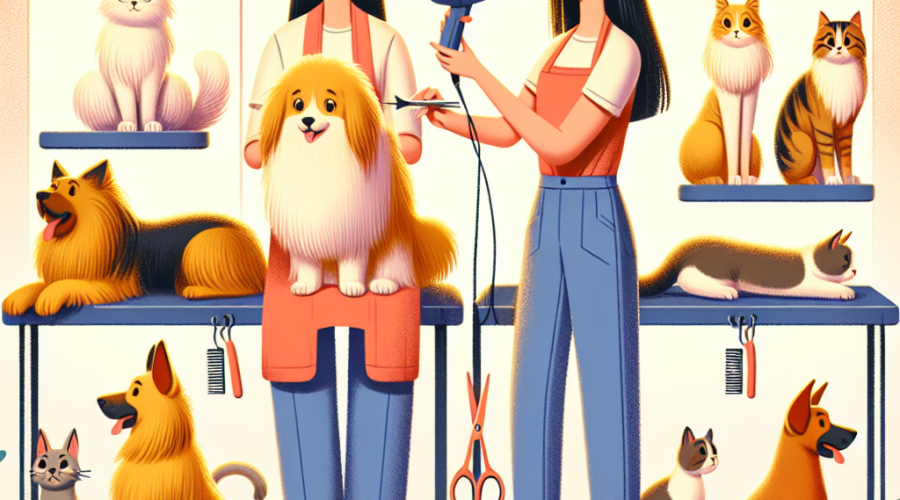Eradicate Pet Hair Woes with Expert Grooming Secrets
As a pet owner, you’re no stranger to the fluffy tumbleweeds that magically appear in every corner of your home or the furry layer that cloaks your favourite black trousers. Pet hair is part and parcel of life with our furry friends, but it needn’t be a source of daily frustration. With some expert grooming secrets in hand, you can significantly reduce the amount of pet hair in your home and keep your beloved companions looking their best.
Understanding your pet’s coat type is the first step in tackling the hairy havoc. Different breeds have different grooming needs. For instance, a Siamese cat will have a vastly different coat to a Siberian, just as a smooth-coated Beagle’s requirements will diverge from those of a fluffy Samoyed. So, what’s the trick to keeping those individual coats in check and your home less like a fur-coated wonderland?
Regular grooming is the cornerstone of managing pet hair. For dogs and cats with long hair, daily brushing is ideal. It not only removes loose fur but also helps distribute natural oils throughout the coat, promoting healthier skin and a shinier fur. Medium-haired pets might get by with a few brushings a week, while short-haired animals can often manage with less frequent grooming sessions. But what tools should you have in your pet-grooming arsenal?
Choosing the right grooming tools can make a world of difference. Slicker brushes, with their fine, short wires close together on a flat surface, are excellent for detangling and removing loose fur. Meanwhile, bristle brushes are great for short-haired breeds, helping to remove dirt and dead hair while adding a nice shine to the coat. Don’t forget the deshedding tools, such as the Furminator, which can drastically reduce hair loss by reaching through the topcoat to remove loose undercoat hair.
But what about those times when, despite your best efforts, pet hair seems to have infiltrated every fibre of your home? A few household hacks can come to your rescue. For instance, did you know that damp rubber gloves can work wonders in lifting pet hair from furniture? Or that a squeegee can be your best friend when it comes to getting fur out of carpets? It’s surprising how everyday items can transform into pet hair removal gadgets.
When it comes to washing your pet, frequency and technique matter. Overbathing can strip essential oils from your pet’s skin, making it dry and itchy, potentially leading to more shedding. But when a bath is due, using the right shampoo can make all the difference. Look for ones that are specifically formulated to reduce shedding and remember to brush your pet before and after the bath to remove loose fur.
You might also consider incorporating supplements into your pet’s diet. Omega-3 and Omega-6 fatty acids are known to improve skin health, which in turn can reduce shedding. Always consult your vet before adding supplements to ensure they’re appropriate for your pet.
Then there’s the question of diet. What you feed your pet has a direct impact on the health of their coat. High-quality, balanced diets are designed to provide all the nutrients your pet needs to maintain a healthy coat. If your pet’s hair seems dull or they’re shedding excessively, it might be worth examining their diet.
Professional grooming services can also be a godsend, especially for those breeds that require more sophisticated grooming techniques that are difficult to carry out at home. These trained experts have the know-how to handle breed-specific requirements, from the perfect poodle pom-poms to the meticulous stripping of a wire-haired terrier’s coat. Plus, they have access to high-grade equipment and products that can make a significant difference in managing shedding.
Remember, shedding is a natural process for pets, and some seasonal shedding is to be expected. However, if you notice your pet is losing hair excessively or there are bald patches, it’s important to consult your vet as it could be a sign of an underlying health issue.
In the end, managing pet hair is about finding the right balance and routine that works for you and your pet. With a bit of knowledge, the right tools, and some patience, you can keep your pet’s coat healthy and your home hair-free, all while enjoying the cuddles and affection that make having a pet so rewarding. Remember, the goal isn’t to eliminate shedding completely but to keep it under control so that you and your furry friend can live together in harmony. Now, isn’t that a purr-fectly delightful thought?
FAQs
Q: What are the best grooming tools to manage my pet’s shedding?
A: The best tools for managing pet shedding are deshedding brushes, slicker brushes, and undercoat rakes. They effectively remove loose fur and help distribute natural oils throughout the coat.
Q: How often should I groom my pet to reduce hair shedding?
A: Ideally, pets should be groomed at least once a week, but breeds with longer hair or those that shed excessively may require more frequent sessions. Regular grooming helps keep shedding under control.
Q: Can diet influence my pet’s shedding and coat health?
A: Yes, a balanced diet rich in omega-3 fatty acids can improve your pet’s coat health and reduce excessive shedding. Integrating high-quality, nutrient-dense pet food into their diet can make a significant difference.
Q: What are some expert grooming secrets to minimize pet hair in the home?
A: Consistent grooming combined with the use of a high-efficiency particulate air (HEPA) filter vacuum and regular laundering of pet bedding can greatly reduce pet hair in the home. Additionally, incorporating grooming wipes or a dampened hand can quickly remove loose hair.
Q: Are there any professional grooming treatments that help with pet hair control?
A: Professional grooming treatments like de-shedding shampoos and conditioners, as well as blow-out services, can greatly reduce the amount of loose hair your pet sheds. Regular visits to a professional groomer can complement your at-home grooming routine.

